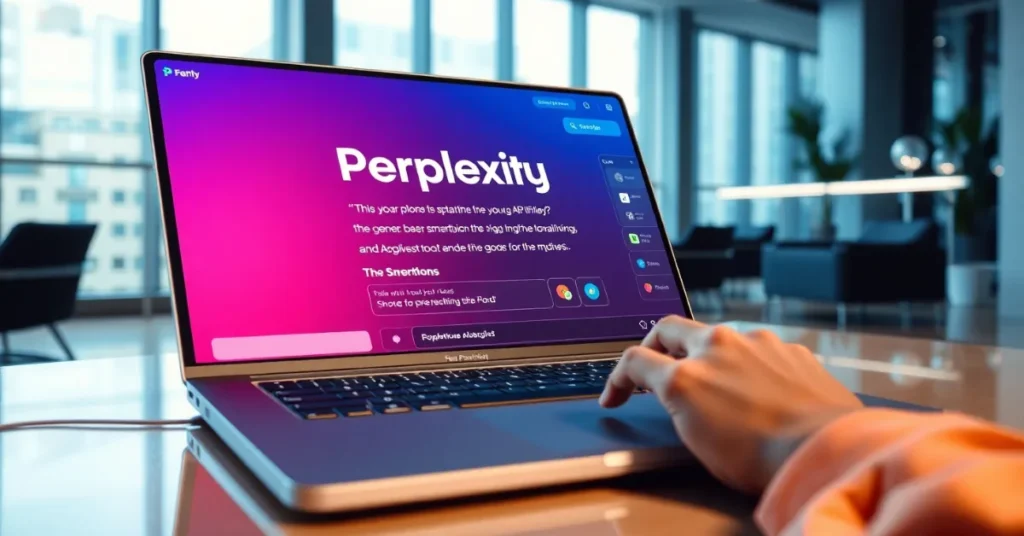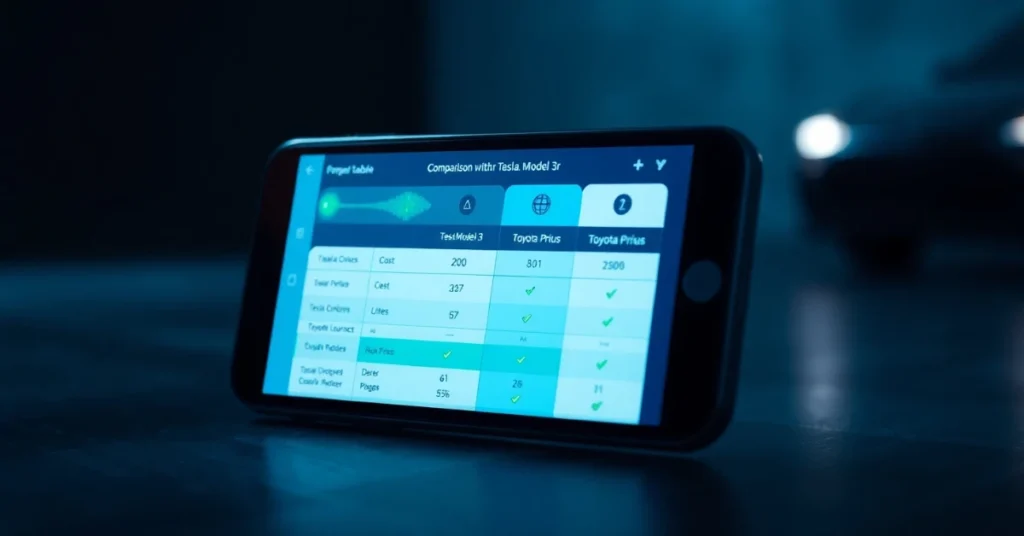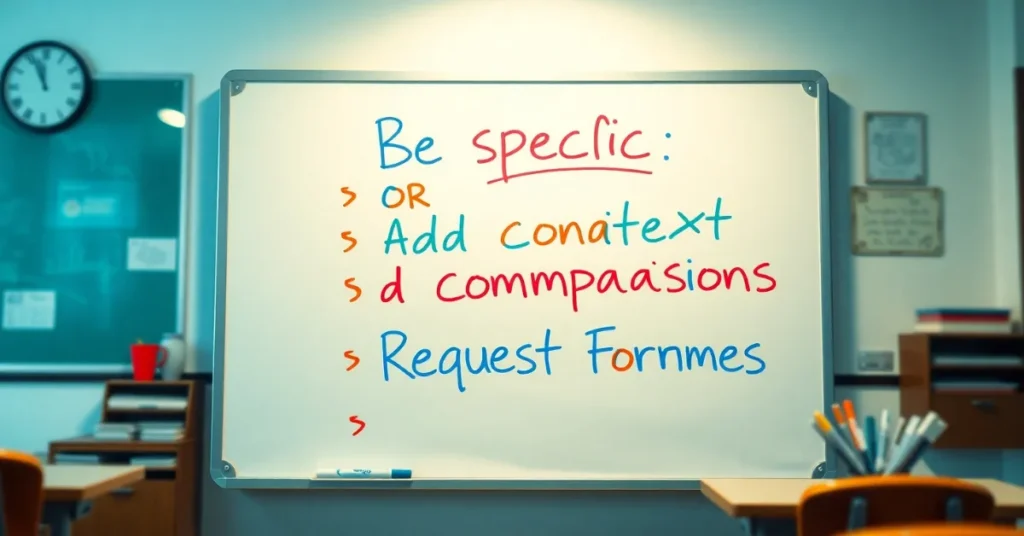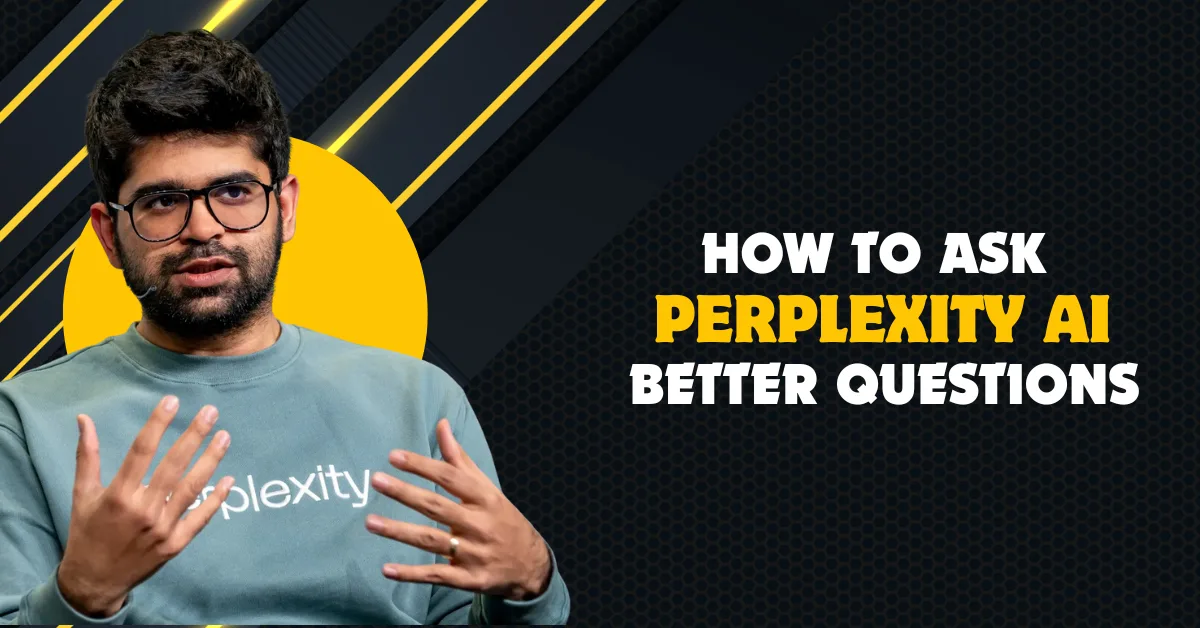Table of Contents
How to Ask Perplexity AI Better Questions: Ever stared at your screen waiting for Perplexity AI to understand what you’re really asking? You’re not alone. 72% of users report getting irrelevant answers simply because they didn’t phrase their questions properly.
Stop wasting time with vague queries and start getting the precise answers you need. Knowing how to ask Perplexity AI better questions isn’t just a nice skill—it’s the difference between useful insights and useless word salad.
The secret lies in understanding how these AI systems process your inputs. When you frame your questions with the right context, specificity and parameters, the quality of responses skyrockets.
But here’s what nobody tells you about prompt engineering with Perplexity AI: the most powerful technique isn’t what you add to your questions—it’s what you strategically leave out.

Understanding Perplexity AI’s Capabilities
What sets Perplexity AI apart from other search tools
Perplexity AI isn’t just another search engine – it’s your research companion that actually understands what you’re asking. Unlike Google, which throws links at you and hopes you’ll find your answer, Perplexity digs into those sources and crafts complete, citation-backed responses.
The magic happens in how it processes your questions. You can ask Perplexity complex questions in plain English – the same way you’d ask a knowledgeable friend. No more keyword gymnastics or boolean operators just to get decent results.
What you’ll immediately notice is that Perplexity gives you direct answers rather than making you click through multiple sites. It’s like having a research assistant who reads everything and summarizes the important bits for you.
The types of queries Perplexity AI excels at
Perplexity really shines when you throw complex, multi-part questions at it. Want to compare several products while also learning about their environmental impact? Just ask in one go.
Your technical and specialized questions get proper treatment too. Ask about coding problems, scientific concepts, or historical contexts, and you’ll get thoughtfully structured responses with reliable sources.
Perplexity also handles follow-up questions brilliantly. You can build on previous queries without restating context, making your research conversations feel natural and efficient. How to Ask Perplexity AI Better Questions.
Common misconceptions about Perplexity AI’s functionality
Many first-time users think Perplexity is just ChatGPT with search capabilities – but you’re missing the bigger picture if you stop there. Perplexity wasn’t built primarily as a creative tool; it’s designed to find and synthesize factual information.
Another mistake is assuming Perplexity will always give you the “right” answer. Remember, it’s pulling from internet sources that might contain conflicting information or biases. You still need to evaluate the quality of sources it cites.
Some users expect Perplexity to work like a traditional search engine where shorter queries work better. In reality, you’ll get more precise results by being specific and detailed with your questions.

Crafting Clear and Specific Questions
How to eliminate ambiguity in your queries
Ambiguity kills your chances of getting helpful answers from Perplexity AI. When you ask “What’s the best phone?” you’re basically throwing a dart blindfolded. Best for what? For photos? Battery life? Budget?
Try this instead: “What’s the best smartphone under $500 for battery life in 2023?” See the difference? You’ve just given Perplexity clear parameters to work with.
Here’s a quick way to check if your question is too vague: Could it be interpreted in multiple ways? If yes, add more specifics.
Using precise terminology for better results
The words you choose make or break your results. If you want info about “cloud storage options for photographers,” don’t just ask about “saving pictures online.”
Industry-specific terms work wonders. Instead of asking about “car problems,” specify “diagnosing P0300 engine code in a 2018 Toyota Camry.” Perplexity loves precision!
The power of context in your questions
Context is your secret weapon. Compare these:
- “Who won yesterday?” (Vague)
- “Who won the NBA Finals game yesterday?” (Clear context)
- How to Ask Perplexity AI Better Questions.
Adding background info dramatically improves responses. Try phrases like “Given that I’m looking for…” or “Considering I already know…”
When to use short vs. detailed questions
Short questions work best for:
- Factual info: “When was the iPhone 13 released?”
- Simple definitions: “What is blockchain?”
- How to Ask Perplexity AI Better Questions.
Detailed questions shine when:
- Comparing options: “What are the pros and cons of React vs. Angular for a small e-commerce site?”
- Seeking advice: “How should I prepare for a marathon with only 8 weeks of training as a beginner runner?”
- How to Ask Perplexity AI Better Questions.
The golden rule: match your question length to the complexity of what you’re asking.

Advanced Query Techniques
A. Leveraging comparison queries for deeper insights
Want to get more valuable information? Try comparison queries. Instead of asking “What’s Python good for?”, try “Compare Python vs JavaScript for web development.” This forces Perplexity AI to evaluate both options side by side, giving you a richer understanding of each.
For best results, be specific about the comparison criteria. “Compare Tesla Model 3 vs Toyota Prius on cost, range, and performance” will yield more useful insights than a general comparison request. How to Ask Perplexity AI Better Questions.
B. How to ask for step-by-step explanations
When tackling complex topics, break them down! Add phrases like “explain step by step” or “walk me through” to your queries. For example, “Walk me through creating a basic neural network in TensorFlow, step by step” will give you a sequential breakdown rather than a wall of text.
This technique works brilliantly for technical processes, cooking recipes, or any multi-stage procedure you’re trying to learn.
C. Requesting specific formats for answers
You can control how Perplexity presents information by specifying your preferred format:
- “List the top 5 renewable energy sources in bullet points”
- “Create a table comparing iPhone models released in the last 3 years”
- “Explain quantum computing in a FAQ format”
- How to Ask Perplexity AI Better Questions.
This approach helps organize complex information in ways that match your learning style or presentation needs.
D. Using follow-up questions effectively
Don’t restart your research journey with each question! Build on previous responses by asking focused follow-ups. After getting an overview of climate change solutions, you might ask, “Which of these solutions has the lowest implementation cost?” or “Expand on carbon capture technologies mentioned above.”
This conversational approach creates a more continuous learning experience and helps you drill down on specific details.
E. Techniques for narrowing down broad topics
Broad queries like “Tell me about artificial intelligence” will give you shallow overviews. Instead, add parameters to focus your query:
- Add time constraints: “Developments in renewable energy since 2020”
- Specify audience level: “Explain blockchain for beginners”
- Focus on aspects: “Social impacts of metaverse technology”
- Include use cases: “Machine learning applications in healthcare”
- How to Ask Perplexity AI Better Questions.
The more specific your constraints, the more tailored and useful your answers will be.

Optimizing Queries by Subject Matter
Specialized approaches for technical questions
When asking Perplexity AI technical questions, specificity is your best friend. Rather than asking “How does React work?”, try “What’s the difference between React’s useEffect and useLayoutEffect hooks?” The more precise your technical query, the more valuable the response.
Include relevant technical versions or frameworks. Instead of “How to fix Python error?”, ask “How to resolve ‘ModuleNotFoundError’ in Python 3.9 when importing TensorFlow?”
Break complex technical problems into smaller parts. If troubleshooting code, share the specific error message and relevant code snippets for context.
Strategies for research-oriented inquiries
Research questions shine when they follow a funnel approach. Start broad, then narrow down based on the information you receive. For instance, begin with “What are the latest developments in quantum computing?” and follow up with “How are these quantum developments being applied in cryptography?”
Add parameters that refine your search – specify date ranges, academic sources, or particular research fields. “Show me studies on climate change impact on coral reefs from 2020-2023” gets you more relevant results than a general climate change query.
Request comparative analysis when appropriate: “Compare research findings on intermittent fasting versus caloric restriction for weight loss.”
Best practices for creative or brainstorming queries
For creative inquiries, embrace open-ended framing. Instead of “Give me blog post ideas,” try “What are unexpected angles for a blog post about sustainable fashion that might surprise readers?”
Set constraints to fuel creativity. “Suggest five unconventional marketing strategies for a small bookstore with a budget under $500” provides boundaries that actually enhance creative thinking.
Use “what if” scenarios to spark imagination: “What if social media disappeared tomorrow? How might businesses adapt their marketing strategies?”
Remember to build on Perplexity’s responses with follow-up questions to dive deeper into the ideas that resonate with you most.

Troubleshooting Poor Responses
A. Identifying why your query failed to deliver
Ever asked Perplexity AI something and got a response that made you go “huh?”—you’re not alone. Most query failures happen for predictable reasons:
- Your question was too vague (“Tell me about dogs”)
- You included contradictory elements (“Find vegetarian beef recipes”)
- You used ambiguous terms (“Show me information about chips”)
- Your query was too complex with multiple unrelated questions
- How to Ask Perplexity AI Better Questions.
Pay attention to how Perplexity responds. If it answers a different question than you intended or provides generic information, that’s your clue something went wrong.
B. Reformulating questions that didn’t work
When your query flops, don’t just repeat it louder! Try these fixes:
- Add specific details: “Tell me about Siberian Huskies as apartment pets” instead of “Are dogs good pets?”
- Clarify your intent: “I need Spanish tapas recipes for beginners” instead of “Spanish food”
- Remove unnecessary words: Trim “I was wondering if you could possibly tell me about…” to “Explain…”
- Use precise terms: “Compare OLED vs Mini-LED TV technology” rather than “Which screen is better?”
- How to Ask Perplexity AI Better Questions.
C. Breaking complex questions into manageable parts
Complex questions overwhelm AI systems just like they overwhelm humans. When your big question bombs:
- Identify the core components of your question
- Ask about each component separately
- Build on previous answers in follow-up queries
- Synthesize the information yourself at the end
- How to Ask Perplexity AI Better Questions.
Instead of “Compare iPhone 15 Pro, Samsung S23 Ultra, and Google Pixel 8 Pro on camera quality, battery life, and value,” try asking about each phone’s camera first, then battery life as a separate query.
D. When to try a completely different approach
Sometimes a fresh start works best:
- Switch from asking for opinions (“What’s the best…”) to requesting facts (“Compare features of…”)
- Try using Focus mode for deeper research
- Rephrase from negative to positive framing
- Use visual aids by requesting “Compare X and Y in a table format”
- Consider whether a different AI tool might better suit your specific query type
- How to Ask Perplexity AI Better Questions.
If you’ve tried three different approaches and still get unsatisfying answers, the information might not be readily available or might require specialized expertise.

Conclusion: Asking Perplexity AI the right questions
Asking Perplexity AI the right questions can dramatically improve your research efficiency and the quality of information you receive. By understanding its capabilities, crafting specific queries, utilizing advanced techniques, and tailoring your approach to different subject matters, you’ll unlock the full potential of this powerful AI tool. Remember that specificity, context, and clear language are your best allies when formulating effective questions.
Don’t be discouraged when you occasionally receive less-than-ideal responses—view them as opportunities to refine your approach. With practice, you’ll develop an intuitive sense for how to phrase your questions for optimal results. Start implementing these strategies today and watch as your Perplexity AI interactions transform from basic information retrieval to insightful, nuanced exchanges that truly enhance your knowledge and decision-making process.

Frequently Asked Questions (FAQs) About How to Ask Perplexity AI Better Questions
What makes Perplexity AI different from Google or Bing?
Perplexity AI goes beyond links—it summarizes answers with citations, processes natural questions, and allows conversational follow-ups for more precise, context-rich insights. How to Ask Perplexity AI Better Questions.
Why do I sometimes get irrelevant answers from Perplexity AI?
Most irrelevant answers happen when queries are too vague, ambiguous, or missing context. Adding specifics like dates, parameters, or intended outcomes improves accuracy. How to Ask Perplexity AI Better Questions.
How do I ask Perplexity AI better questions?
Be clear, specific, and contextual. Instead of “Best phone?” ask “What is the best smartphone under $500 for battery life in 2025?” How to Ask Perplexity AI Better Questions.
Should I use short or long questions with Perplexity AI?
Use short questions for simple facts or definitions.
Use detailed questions for comparisons, research, or advice. Match your question length to the complexity of your need. How to Ask Perplexity AI Better Questions.
How do I use Perplexity AI for complex research?
Start broad, then refine with follow-up questions. For example:
“What are the latest advances in quantum computing?”
“How are these advances applied in cryptography?”
How to Ask Perplexity AI Better Questions.

Can I control how Perplexity formats its answers?
Yes. You can request lists, tables, bullet points, FAQs, or step-by-step guides. Example: “List the top 5 solar energy startups in bullet points. How to Ask Perplexity AI Better Questions.
What’s the best way to compare options using Perplexity AI?
Use comparison queries with clear criteria: “Compare Tesla Model 3 vs Toyota Prius in terms of cost, range, and performance.” This yields richer insights than vague comparisons. How to Ask Perplexity AI Better Questions.
How do I troubleshoot bad responses?
Rephrase vague queries.
Add missing details.
Break complex questions into smaller parts.
Request different formats (e.g., table, pros/cons).
How to Ask Perplexity AI Better Questions.
What are common mistakes when asking Perplexity AI questions?
Being too vague (“Best laptop?”).
Using ambiguous terms (“chips” could mean food or electronics).
Combining unrelated queries.
Expecting a “final truth” instead of nuanced answers.
How to Ask Perplexity AI Better Questions.
How can I use Perplexity AI creatively?
Ask open-ended, scenario-based, or constrained queries:
“What are unusual marketing ideas for a coffee shop under $200 budget?”
“What if smartphones disappeared tomorrow—how would businesses adapt?”
How to Ask Perplexity AI Better Questions.

2 thoughts on “Supercharge Your Queries: How to Ask Perplexity AI Better Questions 2025 🚀”